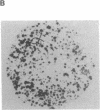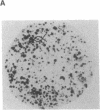Abstract
Diphtheria toxin (DTX)-sensitive mouse cells were isolated from a toxin-resistant thymidine kinase (TK)-negative L-M(TK-) mouse cell population that was transfected with DNA from highly toxin-sensitive monkey Vero cells. Sensitivity to DTX was screened by using a replica plate assay. The purified toxin-sensitive mouse cells were characterized with respect to their ability to bind, internalize, and translocate DTX into the cytosol. In contrast to the L-M(TK-) cells, these DTX-sensitive mouse cells were able to bind and internalize radioiodinated toxin into intracellular vesicles at 37 degrees C. Specific binding of radioiodinated toxin to their cell surface (at 4 degrees C) could not be demonstrated. However, the following evidence for functional receptors capable of binding DTX was obtained: (i) when the toxin-sensitive mouse cells were first allowed to bind DTX at 4 degrees C, followed by washing the cells and shifting the temperature to 37 degrees C (allowing cell surface-bound toxin to enter the cells), the cells were killed; (ii) when cells with surface-bound DTX were exposed briefly to an acidic medium (allowing the toxin to penetrate the plasma membrane directly), protein synthesis was inhibited; and (iii) when cells were incubated with DTX in the presence of the CRM 197, a nontoxic form of DTX with binding properties similar to native DTX, the cytotoxic effect of DTX was markedly decreased. The results demonstrate that the toxin-sensitive mouse cells are killed by a mechanism similar to that observed in naturally occurring toxin-sensitive cell lines. The data further suggest that the transfected mouse cells express functional receptors for DTX.
Full text
PDF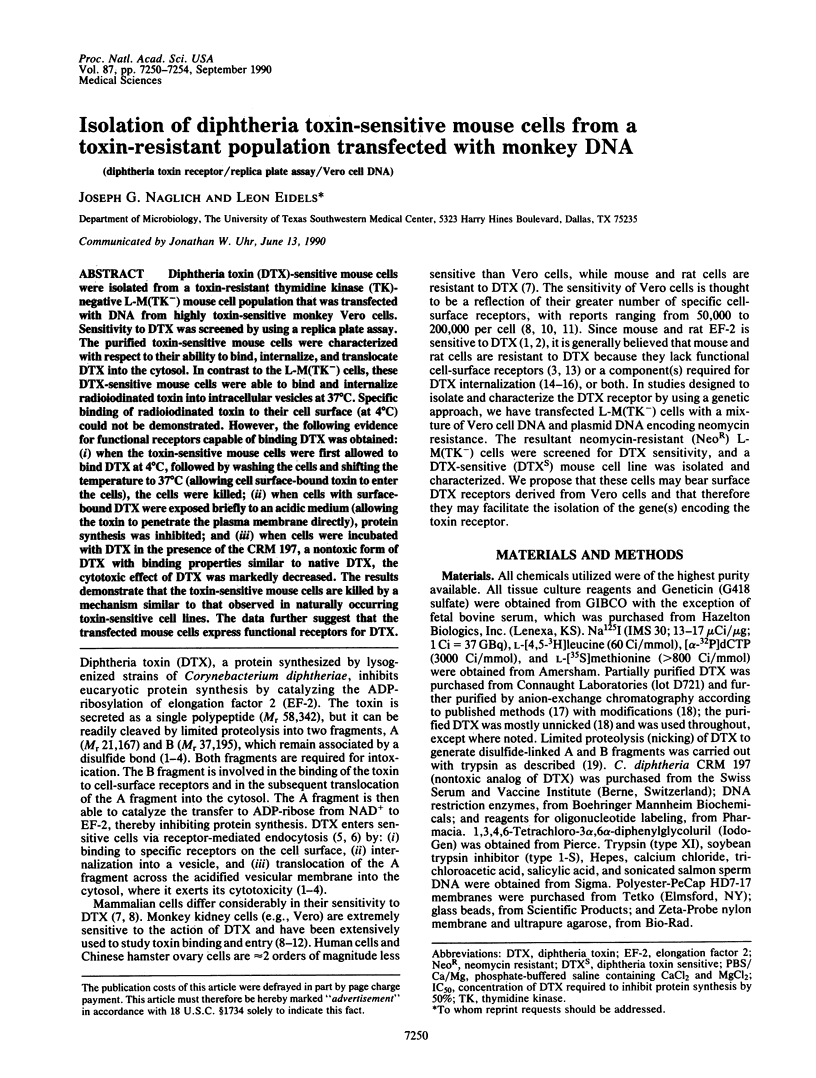
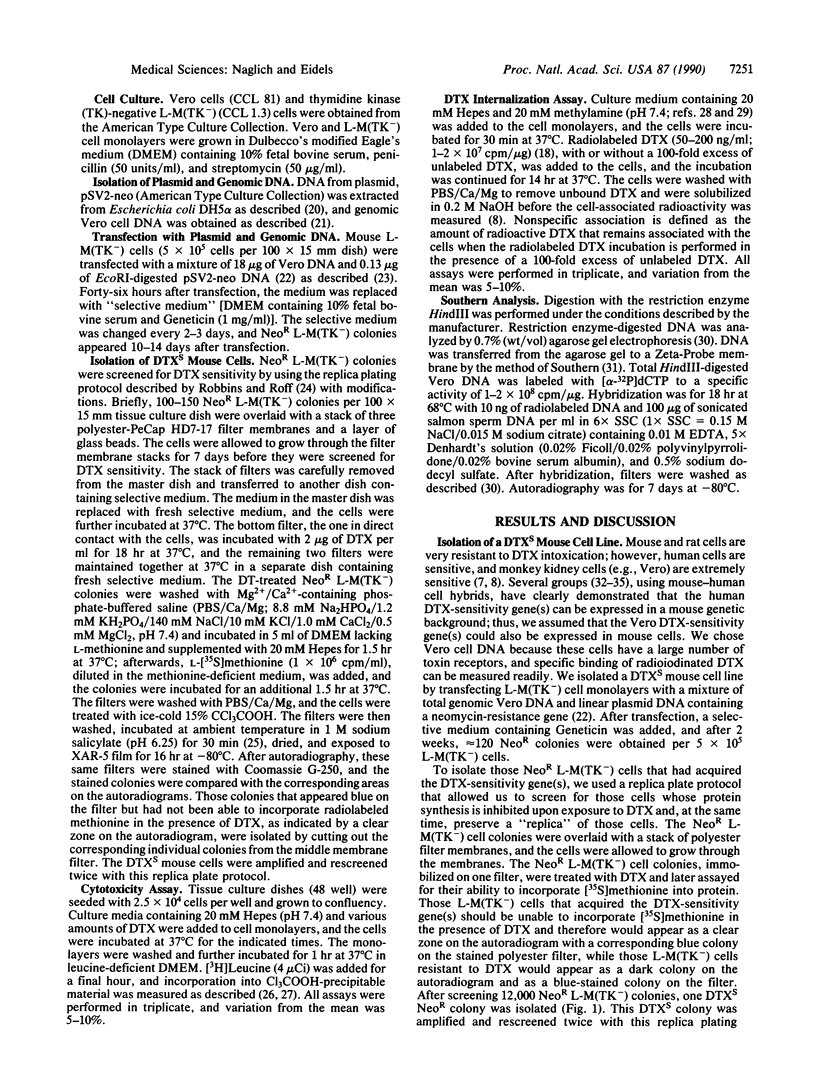
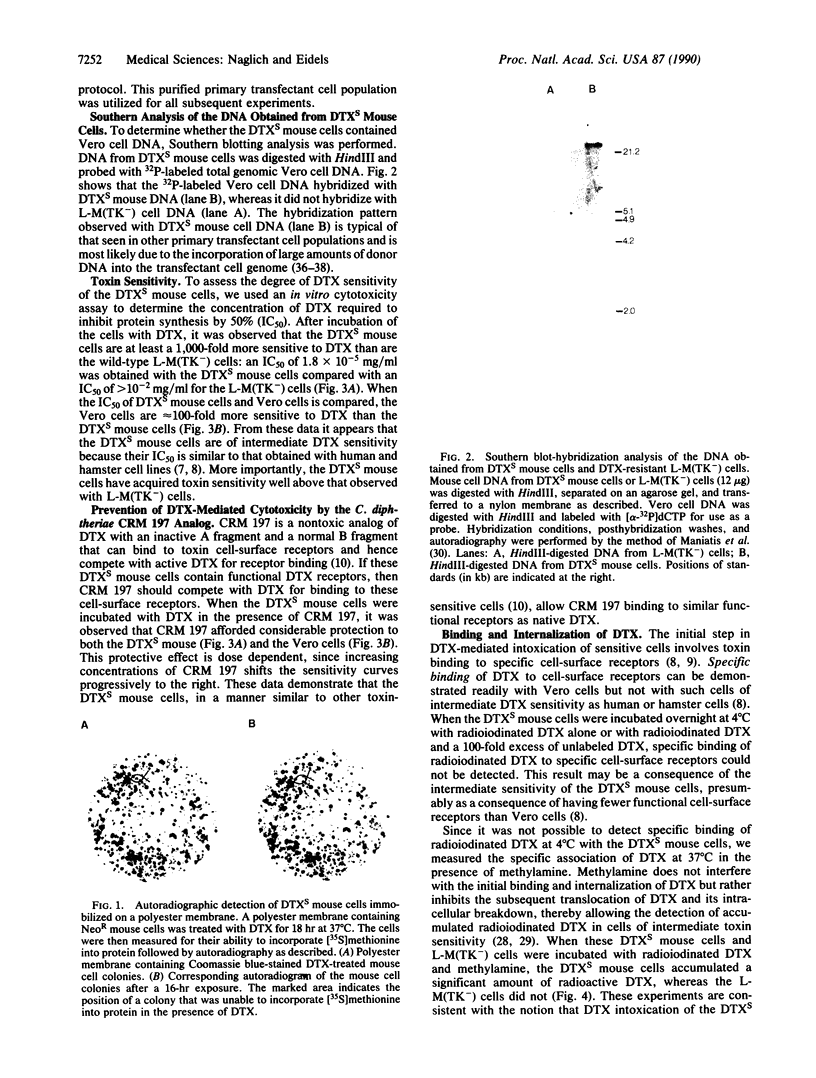
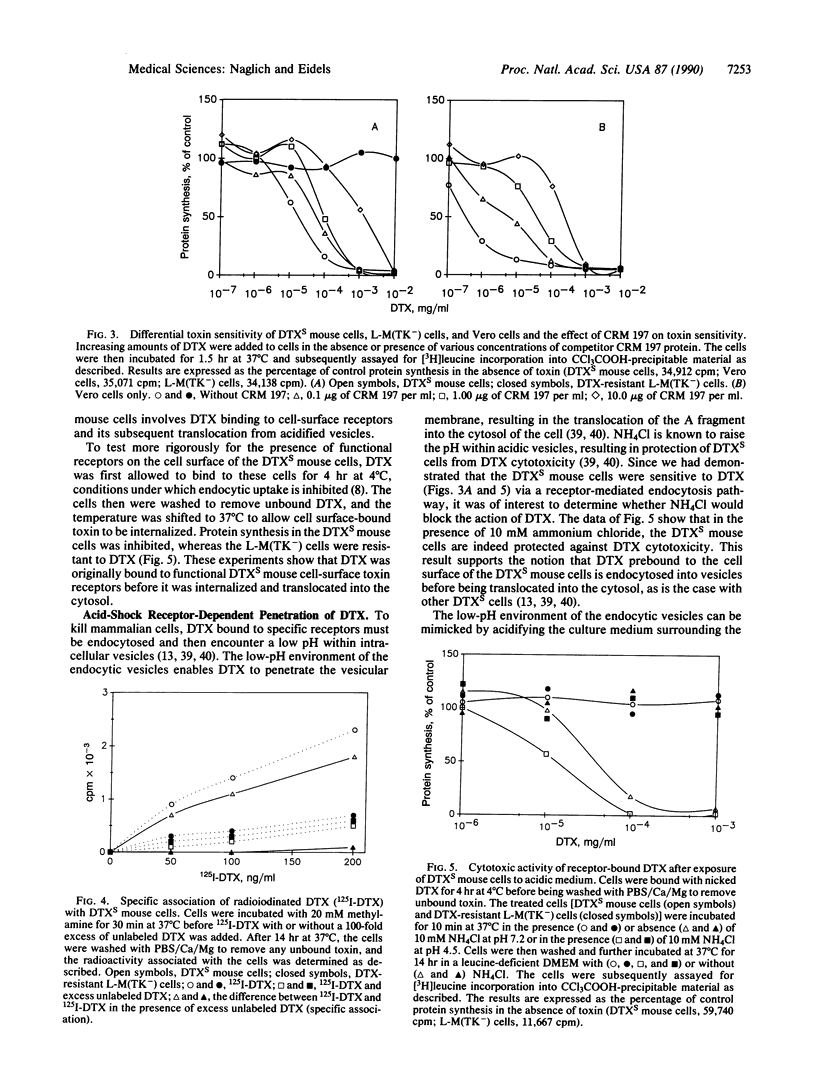
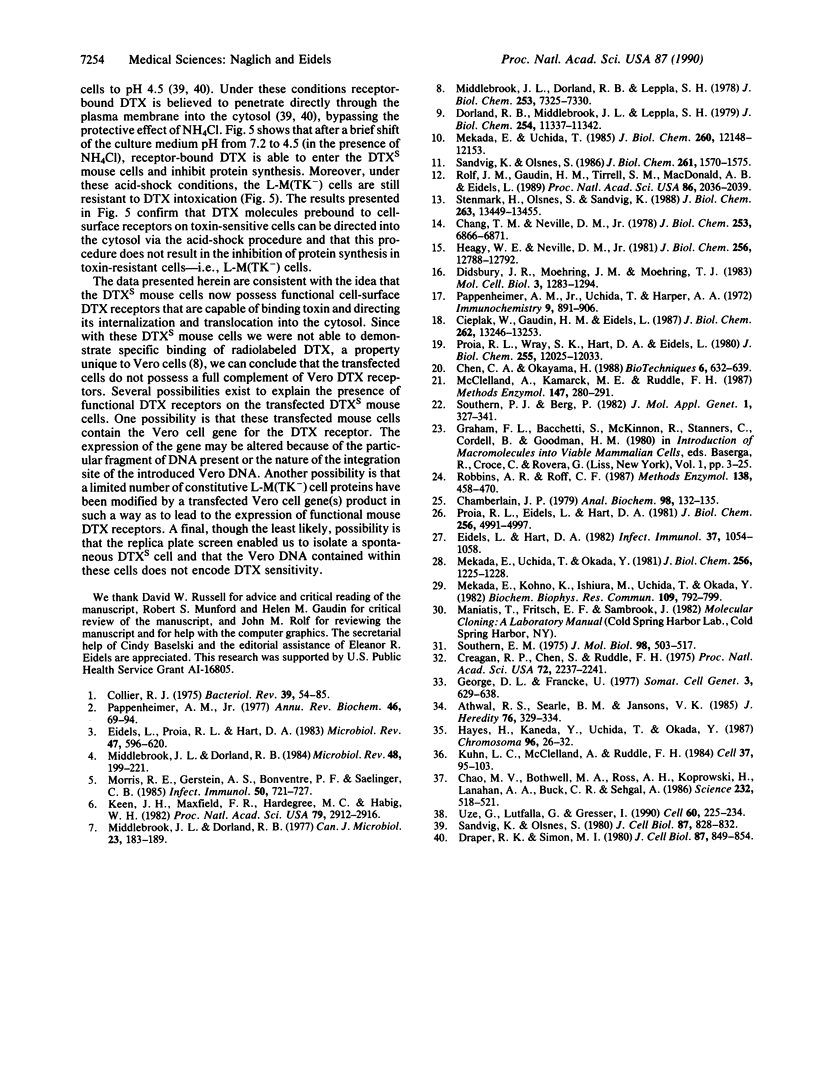
Images in this article
Selected References
These references are in PubMed. This may not be the complete list of references from this article.
- Athwal R. S., Searle B. M., Jansons V. K. Diphtheria toxin sensitivity in a monochromosomal hybrid containing human chromosome 5. J Hered. 1985 Sep-Oct;76(5):329–334. [PubMed] [Google Scholar]
- Chamberlain J. P. Fluorographic detection of radioactivity in polyacrylamide gels with the water-soluble fluor, sodium salicylate. Anal Biochem. 1979 Sep 15;98(1):132–135. doi: 10.1016/0003-2697(79)90716-4. [DOI] [PubMed] [Google Scholar]
- Chang T., Neville D. M., Jr Demonstration of diphtheria toxin receptors on surface membranes from both toxin-sensitive and toxin-resistant species. J Biol Chem. 1978 Oct 10;253(19):6866–6871. [PubMed] [Google Scholar]
- Chao M. V., Bothwell M. A., Ross A. H., Koprowski H., Lanahan A. A., Buck C. R., Sehgal A. Gene transfer and molecular cloning of the human NGF receptor. Science. 1986 Apr 25;232(4749):518–521. doi: 10.1126/science.3008331. [DOI] [PubMed] [Google Scholar]
- Chen C. A., Okayama H. Calcium phosphate-mediated gene transfer: a highly efficient transfection system for stably transforming cells with plasmid DNA. Biotechniques. 1988 Jul-Aug;6(7):632–638. [PubMed] [Google Scholar]
- Cieplak W., Gaudin H. M., Eidels L. Diphtheria toxin receptor. Identification of specific diphtheria toxin-binding proteins on the surface of Vero and BS-C-1 cells. J Biol Chem. 1987 Sep 25;262(27):13246–13253. [PubMed] [Google Scholar]
- Collier R. J. Diphtheria toxin: mode of action and structure. Bacteriol Rev. 1975 Mar;39(1):54–85. doi: 10.1128/br.39.1.54-85.1975. [DOI] [PMC free article] [PubMed] [Google Scholar]
- Creagan R. P., Chen S., Ruddle F. H. Genetic analysis of the cell surface: association of human chromosome 5 with sensitivity to diphtheria toxin in mouse-human somatic cell hybrids. Proc Natl Acad Sci U S A. 1975 Jun;72(6):2237–2241. doi: 10.1073/pnas.72.6.2237. [DOI] [PMC free article] [PubMed] [Google Scholar]
- Didsbury J. R., Moehring J. M., Moehring T. J. Binding and uptake of diphtheria toxin by toxin-resistant Chinese hamster ovary and mouse cells. Mol Cell Biol. 1983 Jul;3(7):1283–1294. doi: 10.1128/mcb.3.7.1283. [DOI] [PMC free article] [PubMed] [Google Scholar]
- Dorland R. B., Middlebrook J. L., Leppla S. H. Receptor-mediated internalization and degradation of diphtheria toxin by monkey kidney cells. J Biol Chem. 1979 Nov 25;254(22):11337–11342. [PubMed] [Google Scholar]
- Draper R. K., Simon M. I. The entry of diphtheria toxin into the mammalian cell cytoplasm: evidence for lysosomal involvement. J Cell Biol. 1980 Dec;87(3 Pt 1):849–854. doi: 10.1083/jcb.87.3.849. [DOI] [PMC free article] [PubMed] [Google Scholar]
- Eidels L., Hart D. A. Effect of polymers of L-lysine on the cytotoxic action of diphtheria toxin. Infect Immun. 1982 Sep;37(3):1054–1058. doi: 10.1128/iai.37.3.1054-1058.1982. [DOI] [PMC free article] [PubMed] [Google Scholar]
- Eidels L., Proia R. L., Hart D. A. Membrane receptors for bacterial toxins. Microbiol Rev. 1983 Dec;47(4):596–620. doi: 10.1128/mr.47.4.596-620.1983. [DOI] [PMC free article] [PubMed] [Google Scholar]
- George D. L., Francke U. Regional mapping of human genes for hexosaminidase B and diphtheria toxin sensitivity on chromosome 5 using mouse X human hybrid cells. Somatic Cell Genet. 1977 Nov;3(6):629–638. doi: 10.1007/BF01539070. [DOI] [PubMed] [Google Scholar]
- Hayes H., Kaneda Y., Uchida T., Okada Y. Regional assignment of the gene for diphtheria toxin sensitivity using subchromosomal fragments in microcell hybrids. Chromosoma. 1987;96(1):26–32. doi: 10.1007/BF00285879. [DOI] [PubMed] [Google Scholar]
- Heagy W. E., Neville D. M., Jr Kinetics of protein synthesis inactivation by diphtheria toxin in toxin-resistant L cells. Evidence for a low efficiency receptor-mediated transport system. J Biol Chem. 1981 Dec 25;256(24):12788–12792. [PubMed] [Google Scholar]
- Keen J. H., Maxfield F. R., Hardegree M. C., Habig W. H. Receptor-mediated endocytosis of diphtheria toxin by cells in culture. Proc Natl Acad Sci U S A. 1982 May;79(9):2912–2916. doi: 10.1073/pnas.79.9.2912. [DOI] [PMC free article] [PubMed] [Google Scholar]
- Kühn L. C., McClelland A., Ruddle F. H. Gene transfer, expression, and molecular cloning of the human transferrin receptor gene. Cell. 1984 May;37(1):95–103. doi: 10.1016/0092-8674(84)90304-0. [DOI] [PubMed] [Google Scholar]
- McClelland A., Kamarck M. E., Ruddle F. H. Molecular cloning of receptor genes by transfection. Methods Enzymol. 1987;147:280–291. doi: 10.1016/0076-6879(87)47118-8. [DOI] [PubMed] [Google Scholar]
- Mekada E., Kohno K., Ishiura M., Uchida T., Okada Y. Methylamine facilitates demonstration of specific uptake of diphtheria toxin by CHO cell and toxin-resistant CHO cell mutants. Biochem Biophys Res Commun. 1982 Dec 15;109(3):792–799. doi: 10.1016/0006-291x(82)92009-5. [DOI] [PubMed] [Google Scholar]
- Mekada E., Uchida T. Binding properties of diphtheria toxin to cells are altered by mutation in the fragment A domain. J Biol Chem. 1985 Oct 5;260(22):12148–12153. [PubMed] [Google Scholar]
- Mekada E., Uchida T., Okada Y. Methylamine stimulates the action of ricin toxin but inhibits that of diphtheria toxin. J Biol Chem. 1981 Feb 10;256(3):1225–1228. [PubMed] [Google Scholar]
- Middlebrook J. L., Dorland R. B. Bacterial toxins: cellular mechanisms of action. Microbiol Rev. 1984 Sep;48(3):199–221. doi: 10.1128/mr.48.3.199-221.1984. [DOI] [PMC free article] [PubMed] [Google Scholar]
- Middlebrook J. L., Dorland R. B., Leppla S. H. Association of diphtheria toxin with Vero cells. Demonstration of a receptor. J Biol Chem. 1978 Oct 25;253(20):7325–7330. [PubMed] [Google Scholar]
- Middlebrook J. L., Dorland R. B. Response of cultured mammalian cells to the exotoxins of Pseudomonas aeruginosa and Corynebacterium diphtheriae: differential cytotoxicity. Can J Microbiol. 1977 Feb;23(2):183–189. doi: 10.1139/m77-026. [DOI] [PubMed] [Google Scholar]
- Morris R. E., Gerstein A. S., Bonventre P. F., Saelinger C. B. Receptor-mediated entry of diphtheria toxin into monkey kidney (Vero) cells: electron microscopic evaluation. Infect Immun. 1985 Dec;50(3):721–727. doi: 10.1128/iai.50.3.721-727.1985. [DOI] [PMC free article] [PubMed] [Google Scholar]
- Pappenheimer A. M., Jr Diphtheria toxin. Annu Rev Biochem. 1977;46:69–94. doi: 10.1146/annurev.bi.46.070177.000441. [DOI] [PubMed] [Google Scholar]
- Pappenheimer A. M., Jr, Uchida T., Harper A. A. An immunological study of the diphtheria toxin molecule. Immunochemistry. 1972 Sep;9(9):891–906. doi: 10.1016/0019-2791(72)90163-2. [DOI] [PubMed] [Google Scholar]
- Proia R. L., Eidels L., Hart D. A. Diphtheria toxin:receptor interaction. Characterization of the receptor interaction with the nucleotide-free toxin, the nucleotide-bound toxin, and the B-fragment of the toxin. J Biol Chem. 1981 May 25;256(10):4991–4997. [PubMed] [Google Scholar]
- Proia R. L., Wray S. K., Hart D. A., Eidels L. Characterization and affinity labeling of the cationic phosphate-binding (nucleotide-binding) peptide located in the receptor-binding region of the B-fragment of diphtheria toxin. J Biol Chem. 1980 Dec 25;255(24):12025–12033. [PubMed] [Google Scholar]
- Robbins A. R., Roff C. F. Isolation of mutant Chinese hamster ovary cells defective in endocytosis. Methods Enzymol. 1987;138:458–470. doi: 10.1016/0076-6879(87)38039-5. [DOI] [PubMed] [Google Scholar]
- Rolf J. M., Gaudin H. M., Tirrell S. M., MacDonald A. B., Eidels L. Anti-idiotypic antibodies that protect cells against the action of diphtheria toxin. Proc Natl Acad Sci U S A. 1989 Mar;86(6):2036–2039. doi: 10.1073/pnas.86.6.2036. [DOI] [PMC free article] [PubMed] [Google Scholar]
- Sandvig K., Olsnes S. Diphtheria toxin entry into cells is facilitated by low pH. J Cell Biol. 1980 Dec;87(3 Pt 1):828–832. doi: 10.1083/jcb.87.3.828. [DOI] [PMC free article] [PubMed] [Google Scholar]
- Sandvig K., Olsnes S. Interactions between diphtheria toxin entry and anion transport in Vero cells. IV. Evidence that entry of diphtheria toxin is dependent on efficient anion transport. J Biol Chem. 1986 Feb 5;261(4):1570–1575. [PubMed] [Google Scholar]
- Southern E. M. Detection of specific sequences among DNA fragments separated by gel electrophoresis. J Mol Biol. 1975 Nov 5;98(3):503–517. doi: 10.1016/s0022-2836(75)80083-0. [DOI] [PubMed] [Google Scholar]
- Southern P. J., Berg P. Transformation of mammalian cells to antibiotic resistance with a bacterial gene under control of the SV40 early region promoter. J Mol Appl Genet. 1982;1(4):327–341. [PubMed] [Google Scholar]
- Stenmark H., Olsnes S., Sandvig K. Requirement of specific receptors for efficient translocation of diphtheria toxin A fragment across the plasma membrane. J Biol Chem. 1988 Sep 15;263(26):13449–13455. [PubMed] [Google Scholar]
- Uzé G., Lutfalla G., Gresser I. Genetic transfer of a functional human interferon alpha receptor into mouse cells: cloning and expression of its cDNA. Cell. 1990 Jan 26;60(2):225–234. doi: 10.1016/0092-8674(90)90738-z. [DOI] [PubMed] [Google Scholar]




